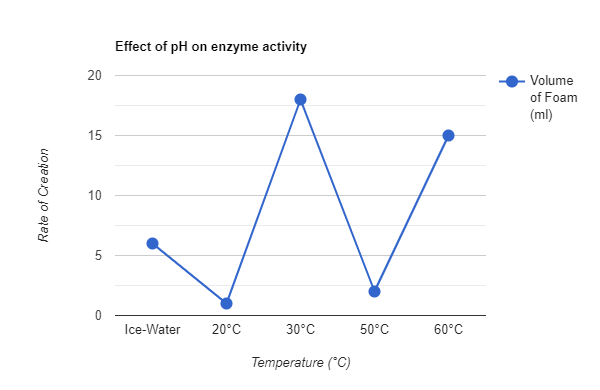Title: Investigate the effect of temperature on the rate of enzyme activity
Materials/Equipment/Apparatus
- Celery
- Scalpel
- Weigh boat
- Electric balance
- Cutting board
- Buffer pH solution
- Washing up liquid
- Graduated cylinder
- Beaker
- Boiling Tubes
- Water bath
- Thermometer
- Water
- Hydrogen Peroxide
Procedure/Method
- Chop the celery into fine pieces using the scalpel. Weigh 5g and get 5g of chopped celery
- Add 20ml of the buffer pH solution, a drop of washing up liquid and the 5g of celery into your graduated cylinder
- Put 2ml of hydrogen peroxide into a boiling tube
- Set up your water bath to be at your desired temperature and place the graduated cylinder and the boiling tube into the water bath and wait 2 minutes
- Pour the hydrogen peroxide into the graduated cylinder and record the volume of the graduated cylinder
- Wait 2 minutes and record the final volume of the graduated cylinder
Safety/Risks
- Hydrogen Peroxide can cause burns and is corrosive
- Tie back hair
- Wear googles
- Wear gloves
- Only handle the Hydrogen Peroxide only when you need to
Labelled Diagram


Results
| Temperature (°C) | Initial Volume (cm³) | Final Volume (cm³) | Volume of Foam (cm³) |
|---|---|---|---|
| Ice Water | 22ml | 28ml | 6ml |
| 20°C | 21ml | 22ml | 1ml |
| 30°C | 21ml | 39ml | 18ml |
| 50°C | 28ml | 30ml | 2ml |
| 60°C | 43ml | 58ml | 15ml |
Conclusion
We have found out that enzyme activity is different depending on the temperature level and that enzyme activity is highest when there is a temperature of 30 degrees with 18ml of foam and lowest when there is a temperature of 20 degrees with 1ml of foam.
Graph
